| |
 |
A brief
History of UNGR... |
 |
| |
 |
UNGR
started back in 1999 as 'The Ultimate NeoGeo Resource' (see the
shots below), back then it was a relatively simple neogeo fan
site, hosted on my internet account webspace and listing my favourite
neogeo games. It recieved around 7000 hits in its first couple
of months, which wasnt bad, so I expanded the site with more game
info, artwork and players guides. Around that time I recieved
an email from 'The Fox' of Emulators Unlimited who invited me
to add UNGR to their family of websites, and so at Xmas 1999 this
site took up a new home at emuunlim.com.
Since then the site has grown to feature ratings, screenshots
and comments for every available neogeo game, artwork such as
game marqees & flyers plus players guides and neogeo emulators.
And now four years later, in its latest incarnation of 'Ultimate
Neo Gaming Resource' I have rebuilt the site from scratch bringing
it up to date, with an improved look and layout and all the latest
neo information.
enjoy...
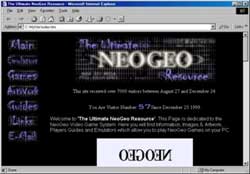 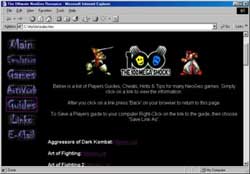
|
 |
 |
 |
 |
 |
| |
 |
A brief
History of the NeoGeo... |
 |
| |
 |
Towards the end of the 1980's home videogame
consoles were introduced to the world, Nintendo's 'NES' and
Sega's 'Master System' proved extremely popular and many people
chose to stay at home and play 'Mario Bro's' rather than go
to video arcades. As such the popularity of arcades dropped,
and when the 16-bit systems such as the 'SNES' and 'Genesis
/ Megadrive' appeared their superior graphics and sound capabilities
made the arcades seem far less cutting edge.
In 1989 Shin Nihon Kikaku, 'SNK' (or New Japanese Project)
decided to introduce themselves to the arcade market with
a brand new system, after producing other successful games
such as 'Ikari Warriors'. This decision was questionable as
SNK were not a major contributor to the industry and the number
of arcade-goers had fallen considerably. SNK's new system
was called the 'NeoGeo MVS' (Multi Video System) it was composed
of two common main processors, a 16-Bit 68000 and a 8-Bit
Z80, but alongside a custom graphics chipset which allowed
visuals which were considerably better than it's nearest rival.
This combined with the ability to store multiple games in
a single system, which could be swiched between at will and
a huge ROM Storage capacity of 330 Megabits (over 41 Megabytes)
were the key to it's success. |
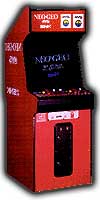 |
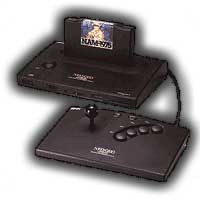 |
Shortly after the arcade system appeared, the
hardware was converted into a home system called the AES (Advanced
Entertainment System), which boasted games identical to the
arcade, but it's cost prevented it from becoming a mainstream
system, a console which cost over $500 US, and games costing
over $200 US each was not practical for the average gamesplayer.
AES cartriges used a different configuration to MVS, so MVS
carts could not simply be plugged into a home system. It is
possible to transfer the rom chips into a home cart with some
significant rewiring, or MVS-AES Converters such as the 'Phantom-1'
can be used.
In 1992 a new generation of Games and arcade goers had appeared,
Capcom's 'Street Fighter 2' had become very popular and the
NeoGeo was pefectly suited to power similar games. SNK introduced
'Fatal Fury' and 'Art of Fighting' two games which would spawn
many sequels and clones and make the NeoGeo a sure success. |
A few years later SNK decided to re-design the
home version of the NeoGeo and chose CD as the replacement
for the expensive ROM chips, this would cut the cost of games
and allow high quality CD music. Unfortunately this second
attempt at the home market fared little better than the first,
the system itself was still over $300 US and Its CD-ROM drive
was only single speed resulting in long loading pauses. A
improved version with faster loading times (NeoGeo CDZ) was
released in japan shortly after but it's distribution was
rather limited.
In the Arcades however the NeoGeo MVS remained king, the superbly
detailed arcade games such as 'Metal Slug' and 'The King of
Fighters' with their super-smooth animation and great gameplay
kept people coming back for more. Even now when the system
is well over ten years old, games developers are still pushing
the limits of the NeoGeo. The ROM Capacity of the cartriges
has been increased with the 'Giga-Power' feature, allowing
better graphics and more animation, and the systems popularity
is as high as ever. |
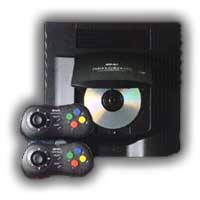 |
For further details on the NeoGeo please read Chris
Mullins' NeoGeo FAQ
|
 |
 |
 |
 |
 |
|
|

